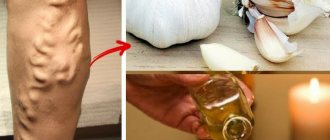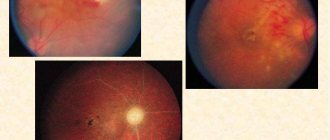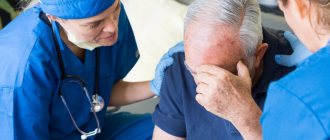Causes
For thrombophlebitis to occur, one or more of three factors must be present (the so-called Virchow triad):
- Damage to the vein wall (can be either mechanical, due to injury, or chemical - a burn from the administration of concentrated drugs, narcotic substances)
- Violation of the rheological properties of blood (increased coagulability, viscosity, etc.). This happens with dehydration, certain diseases, hormonal, and genetic disorders.
- Slowing of blood flow in the vein (when the vein is compressed, movement is limited (for example, when wearing a plaster cast)).
Under the influence of one or several factors, a blood clot forms in the lumen of the vessel and inflammation of its wall occurs. Example: with a serious leg injury, all three factors are present - mechanical damage (tears in the vein wall due to an impact), increased coagulability (due to blood loss), slowdown of blood flow (tissue swelling, plaster application).
Usually, with thrombophlebitis of the superficial veins, one vein is affected; inflammation can also spread to its tributaries. Migrating thrombophlebitis is known - with it, sequential inflammation of several veins occurs in different parts of the limbs. Such thrombophlebitis requires additional diagnostics to exclude oncological processes or genetic coagulation disorders.
Varicose veins - what is it and how to live with it?
As an advertisement
Varicose veins are a very common phenomenon. According to statistics, in Russia various forms of varicose veins occur in 30 million people. Women experience the disease more often than men1.
With varicose veins, the walls of blood vessels lose their elasticity and become thinner. The veins themselves become tortuous, and nodular protrusions appear under the skin. Due to the deformation of blood vessels, the venous outflow of blood is disrupted2.
Symptoms of varicose veins of the legs
With varicose veins, symptoms vary depending on the stage of the disease3.
I. At the initial stage
Varicose veins may not manifest themselves in any way, so diagnosing the disease is quite difficult. However, without treatment, over time, a feeling of heaviness and fullness in the legs, swelling, and calf cramps arise. Spider veins are added to the signs of varicose veins in women, but without accompanying symptoms it can simply be a cosmetic defect.
II. At the second stage
swelling and fatigue no longer go away after a night's rest. The skin on the legs may become less sensitive, dryness and flaking appear, sometimes reddish or dark spots, itching.
III. At the third stage
changes in veins and skin are visible to the naked eye. Venous vessels become swollen. There is constant pain in the legs, the skin in some places acquires a bluish tint. Patients are increasingly experiencing cramps in their calves. Systemic problems begin due to impaired blood flow, for example, headaches.
IV. At the last – fourth stage
manifestations of varicose veins progress. Trophic ulcers appear in places of inflammation on the skin. The risk of blood clots and thrombophlebitis – inflammation of the veins – increases.
Also, with varicose veins, the local temperature may increase. In the later stages, even minor bruises and wounds on the lower leg lead to minor hemorrhages4.
Why do varicose veins appear?
There are primary and secondary varicose veins5:
• primary varicose veins are caused by congenital, often hereditary, factors: insufficiency of the venous wall or valves that direct blood flow from the lower extremities to the heart;
• the development of the secondary form of varicose veins is influenced by a person’s lifestyle and occupation.
Representatives of professions with a static load are at greatest risk, when they have to sit or stand motionless for a long time, or lift heavy objects. These are, for example, surgeons, teachers, waiters. The disease is more likely to develop in obese people6.
Some causes of varicose veins apply only to women7:
• dyshormonal conditions, including those caused by taking hormonal contraception, replacement therapy;
• Pregnancy also increases the risk of the disease, but in most women, after childbirth, the veins return to a healthy state.
Is it possible to cure varicose veins?
Many changes in the veins are irreversible, so at the first signs of varicose veins you should consult a phlebologist. To make a diagnosis, a specialist will conduct an examination, perform hardware diagnostics and prescribe tests.
If the disease is severe, the main treatment will be surgical. Minimally invasive methods such as sclerotherapy or laser coagulation are possible8.
In the early stages of varicose veins, conservative treatment is sufficient, which may include:
• venotonics, improving blood flow and strengthening the walls of blood vessels. For example, Venolife duo® is a complex drug that helps strengthen capillaries and increase venous tone9;
• anticoagulants, which thin the blood and prevent blood clots from forming. Venolife® gel prevents blood clots, helps cope with swelling and pain in the legs, accelerates the healing of trophic ulcers10;
• anti-inflammatory drugs;
• compression underwear.
To prevent varicose veins, it is recommended to normalize weight, eat right and exercise. If you work sedentary or standing, you can wear compression socks or stockings.
THERE ARE CONTRAINDICATIONS. BEFORE USE, CONSULT A PROFESSIONAL.
Products by topic: [product](Venolife gel), [product](Venolife Duo).
1. Litynsky A.V., Polyakov P.I., Gorelik S.G. Modern problems of varicose veins of the lower extremities (epidemiology, diagnosis, treatment) and its features in people of older age groups // Scientific bulletins of Belgorod State University. Series: Medicine. Pharmacy. 2012. No. 5 (part 2). pp. 276-280.
2. Daudyaris J.P. Diseases of the veins and lymphatic system. // M.: “Medicine”, 1984. P. 59-97.
3. Ibid.
4. Petukhov V.I. The nature of functional disorders in patients with varicose veins and the possibilities of sclerotherapy // Bulletin of Vitebsk State Medical University. 2005. No. 2, volume 4. pp. 22-27.
5. Evdokimov A.G., Topolyansky V.D. Diseases of the arteries and veins: A reference guide for the practitioner. // 2nd ed. M.: Soviet sport, 2001. P. 182.
6. Clinical recommendations. Varicose veins of the lower extremities without chronic venous insufficiency // Ministry of Health of the Russian Federation.
7. Ibid.
8. Ibid.
9. Venolife Duo, instructions. // https://www.venolife.ru/instructionDuo.pdf
10. Venolife Gel, instructions. // https://www.venolife.ru/instructionGel.pdf
Symptoms, diagnosis
Diagnosing thrombophlebitis of the superficial veins is usually not difficult. Patients complain of pain, a painful compaction in the form of a “cord” in the projection of the saphenous vein. The skin over the lump is often hyperemic (redness). There may be a slight increase in body temperature. Most often, varicose veins become inflamed. There are frequent cases of phlebitis after intravenous injections. Thrombophlebitis may occur without any apparent reason. In this case (and especially with recurrent, migrating thrombophlebitis), a genetic analysis for thrombophilia and exclusion of oncological processes is needed.
Of the additional research methods, ultrasound (duplex angioscanning) is of greatest importance. In doubtful cases, it allows you to accurately make a diagnosis, as well as identify complications (transition of phlebitis to deep veins, etc.).
Laboratory methods have little diagnostic value - a slight increase in leukocytes and ESR in a general blood test is possible. There are usually no changes in the coagulogram (clotting test). Laboratory diagnostics becomes important for recurrent and migrating thrombophlebitis - in this case, coagulogram abnormalities can be detected, as well as changes in genetic analysis.
In itself, thrombophlebitis of the superficial veins is not dangerous - thromboembolism (separation and migration of a blood clot into the pulmonary artery) never occurs with it. Only ascending thrombophlebitis of the trunks of the small and great saphenous veins is dangerous. In this case, phlebitis can spread up the vein, and, upon reaching the place where the superficial veins flow into the deep ones, spread to them, which can already be fraught with thromboembolism.
How do varicose veins occur on the legs?
To have an idea of the reasons for the appearance of dilated veins, let us recall the structure of blood vessels in the lower extremities of a person. The blood in the veins, with each heartbeat, overcomes the laws of physics, moves from bottom to top. This process involves special venous valves that prevent blood from going down. It is the dysfunction of the valves of the venous vessels that provokes the occurrence and further development of varicose veins. There is an inevitable dilation of blood vessels, loss of their tone and an unpleasant aesthetic appearance of the limbs (especially on the legs).
Treatment of phlebitis
Thrombophlebitis should be treated by a doctor (surgeon or phlebologist). Along with treatment, the doctor must monitor the patient so that if there is a threat of phlebitis spreading to the deep veins, the patient can be hospitalized in a hospital in a timely manner.
The patient is advised to rest, although bed rest is not necessary.
Several groups of drugs are used to treat uncomplicated thrombophlebitis:
- Non-steroidal anti-inflammatory drugs (Voltaren, Nimesil, etc.)
- Phlebotonics (detralex)
- Antiplatelet agents (thrombo-ASA)
- Local products containing heparin (Lioton-gel).
Drugs that directly affect blood clotting (anticoagulants) are usually not used for thrombophlebitis of the superficial veins, although in some cases (with recurrent, migratory thrombophlebitis) their use is possible.
It is a mistake to prescribe antibiotics - inflammation in thrombophlebitis is almost never microbial. Purulent thrombophlebitis is a very rare phenomenon; it can develop after injections with non-sterile syringes or after injuries that violate the integrity of the skin.
If there is a threat of transition of phlebitis from superficial to deep veins, an emergency operation is performed - ligation of the affected vein, which prevents further spread of the process. The intervention is performed in a hospital.
Acute inflammatory phenomena (pain, redness) usually subside within a week, and a blood clot in the lumen of the vein resolves within a few weeks.
Diagnosis of varicose veins in Kyiv
To determine the stage of development of varicose veins, a primary consultation with a phlebologist is first carried out, during which a face-to-face examination of the patient is carried out, an anamnesis is taken, a survey is carried out regarding the presence of a similar pathology in close relatives, as well as palpation of skin lesions with varicose veins found on the legs. To make an accurate diagnosis, the doctor must offer the patient a special ultrasound examination, called duplex scanning of the vessels of the lower extremities with mapping of blood flow in them. This is a painless procedure, during which the vascular surgeon determines the speed of blood flow and its direction in the vessels.
The medical clinic in Kyiv has installed modern ultrasound equipment, with the help of which it is possible to accurately determine the affected valves in the venous vessels, as well as mark the projection of the vessels on the skin. In the future, this will help to efficiently remove dilated veins during surgical removal of varicose veins [3].
After making an accurate diagnosis, localization, stage of varicose veins, and its morphological assessment, the doctor suggests undergoing treatment, which can be either conservative or surgical, using medical laser systems.










